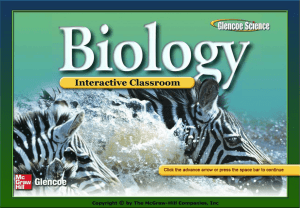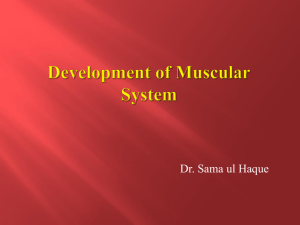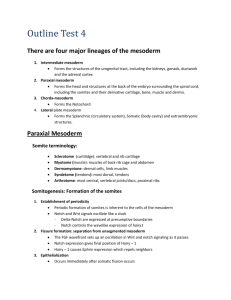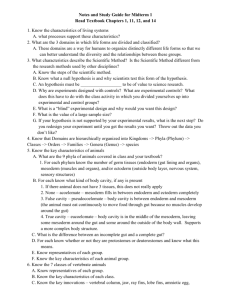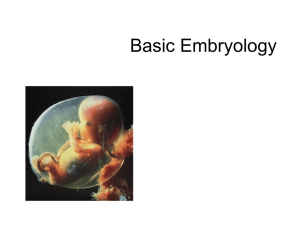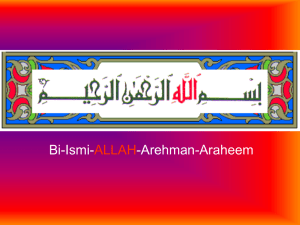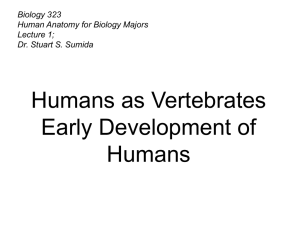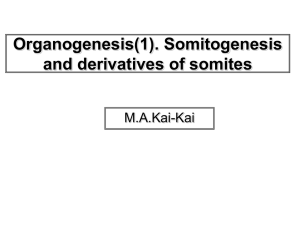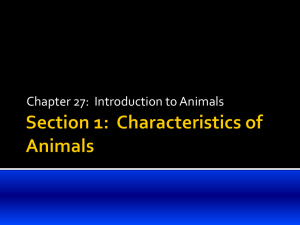Exam 4 Outline Paraxial and Intermediate Mesoderm
advertisement
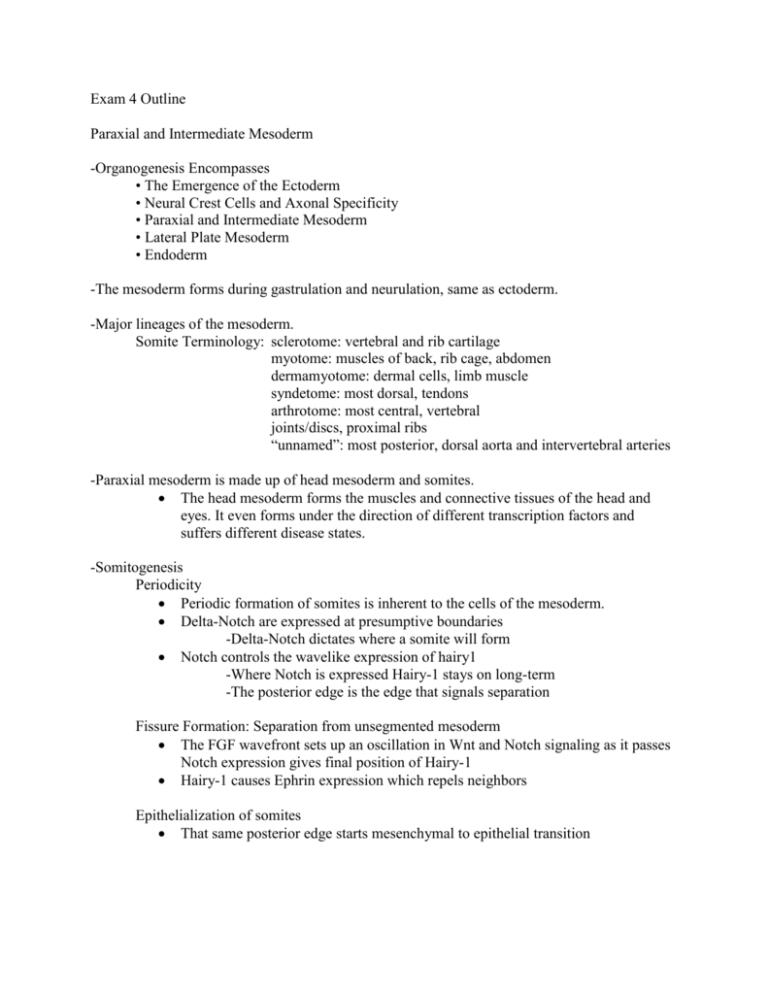
Exam 4 Outline Paraxial and Intermediate Mesoderm -Organogenesis Encompasses • The Emergence of the Ectoderm • Neural Crest Cells and Axonal Specificity • Paraxial and Intermediate Mesoderm • Lateral Plate Mesoderm • Endoderm -The mesoderm forms during gastrulation and neurulation, same as ectoderm. -Major lineages of the mesoderm. Somite Terminology: sclerotome: vertebral and rib cartilage myotome: muscles of back, rib cage, abdomen dermamyotome: dermal cells, limb muscle syndetome: most dorsal, tendons arthrotome: most central, vertebral joints/discs, proximal ribs “unnamed”: most posterior, dorsal aorta and intervertebral arteries -Paraxial mesoderm is made up of head mesoderm and somites. The head mesoderm forms the muscles and connective tissues of the head and eyes. It even forms under the direction of different transcription factors and suffers different disease states. -Somitogenesis Periodicity Periodic formation of somites is inherent to the cells of the mesoderm. Delta-Notch are expressed at presumptive boundaries -Delta-Notch dictates where a somite will form Notch controls the wavelike expression of hairy1 -Where Notch is expressed Hairy-1 stays on long-term -The posterior edge is the edge that signals separation Fissure Formation: Separation from unsegmented mesoderm The FGF wavefront sets up an oscillation in Wnt and Notch signaling as it passes Notch expression gives final position of Hairy-1 Hairy-1 causes Ephrin expression which repels neighbors Epithelialization of somites That same posterior edge starts mesenchymal to epithelial transition Specification of paraxial mesoderm occurs early due to Hox expression transplants form what they would have in original position Determination and differentiation in somites All of the cells of the somite are competent to form all of the derivative cell types -cartilage, bone, muscle, tendons, dermis, vascular cells, meninges Their fate depends on their position near the neural tube, notochord, epidermis and intermediate mesoderm First step is notochord induction of sclerotome Epithelial to mesenchymal transition causes them to migrate to form vertebral cartilage, leaves dermamyotome epithelium The second step is the segregation of dermamyotome Central and bilateral myotome surrounds dermatome Dermatome forms back dermis, brown fat - Primaxial myotome forms back and intercostal muscles - Abaxial myotome forms abdominal muscle, tongue, limbs - Central myotome proliferates madly and makes most cells -Mechanisms of Tissue Formation from Somites Myogenesis: Muscle Formation The paraxial, abaxial and central somite Cells in the center give rise to satellite cells – maybe stem cells, maybe committed progenitors – remain viable for the life of the organism – exit cell cycle upon injury and differentiate to muscle Classic skeletal muscle differentiation – paracrine signals induce MyoD, Myf-5 – TFs for muscle genes and for themselves Adult muscle cells (myotubes) are large and multinucleated In culture it doesn’t matter what species you place together they will fuse. Osteogenesis: Bone Formation Four different sources of bone: – Somites form the axial skeleton – Lateral plate mesoderm form the limb skeleton – Cranial neural crest forms the bones of face and head – Mesodermal mesenchyme in patella, periosteum Two different processes: – Endochondrial ossification in the first two – Intramembraneous ossification in the second two Vascular Replacement in the Dorsal Aorta -Blood vessels are a single layer of endothelium surrounded by multiple layers of smooth muscle -The dorsal (or descending) aorta forms a primary model by vasculogenesis and then both the endothelium and smooth muscle are replaced by somite. The Syndetome: Tendon Formation Tendon joins bone to muscle. The last row of sclerotome is induced by the overlying myotome to differentiate into those connectors. -Formation of the Kidneys from Intermediate Mesoderm The adult kidney is very complex – A single nephron has 10,000 cells, 12 cell types – Each is positioned exactly for its job relative to others The embryo increasingly needs to filter blood – IM mesoderm 1st forms organizer, the pronephric duct – This tissue then induces three stages of kidney – The first two are transitory, the third persists Lateral mesoderm and endoderm -Organogenesis Part 2 Lateral Plate Mesoderm Terminology: - Somatopleure: somatic mesoderm plus ectoderm - Splanchnopleure: splanchnic mesoderm plus endoderm - Coelom: body cavity forms between them The Coelom: – eventually left and right cavities fuse into one – runs from neck to anus in vertebrates – portioned off by folds of somatic mesoderm • pleural cavity: surrounds the thorax and lungs • pericardial cavity: surrounds the heart • peritoneal cavity: surrounds the abdominal organs Heart Development The heart is the first organ to function in the embryo and the circulatory system is the first functional system. – heart�arteries�capillaries�veins�heart Before the embryo can get very big it must switch from nutrient diffusion to active nutrient transport Tube Formation presumptive heart cells are specified but not determined in the epiblast outflow forming cells (red) migrate in first, inflow second The cardiogenic mesoderm migrates out of the mesodermal layer towards the endoderm to form endocardial tubes on either side. At the same time the endoderm is folding inward The endoderm continues folding inward until it forms its own tube, which drags the two endocardial primordia close to each other. The endocardial tubes are surrounded by myocardial progenitors When the endocardial tubes get close enough, they fuse together If you mess with endoderm migration or signaling, you end up with two hearts Heart Tube Cell Biology Splanchnic mesoderm cells express cadherins and form an epithelial sheet for their inward migration - MET The presumptive endocardial cells undergo EMT to migrate away from the sheet and another MET to form tubes The cells in the original mesodermal sheet form the myocardium The myocardial epithelium fuses first and the two endocardial tubes exist together inside for a while before fusing Both the rostral end (outflow) and caudal end (inflow) remain as unfused double tubes The heart beat starts spontaneously as myocardial cells express the sodium-calcium pump - before fusion is even complete Looping and Chamber Formation left-right asymmetry is due to Nodal and Pitx2 Looping requires: cytoskeletal rearrangement extracellular matrix remodeling asymmetric cell division heart valves keep the blood from flowing back into the chamber it was just ejected from The septa separate the two atria and the two ventricles The truncus arteriosis, or outflow tract, also becomes septated allowing one great artery to flow from right ventricle to lungs and the other from left ventricle to the body. The tricuspid valve is between the right atrium and right ventricle. The pulmonary or pulmonic valve is between the right ventricle and the pulmonary artery. The mitral valve is between the left atrium and left ventricle. The aortic valve is between the left ventricle and the aorta. Steps: 1. Endocardial cushions form and fuse 2. Septa grow towards cushion 3. Valves form from myocardium In utero, the foramen ovale allows right left shunting of blood All of the blood must circulate outside of the embryo for oxygenation Blood Vessel Development The vessels form independently of the heart They form for embryonic needs as much as adult – Must get nutrition before there is a GI tract – Must circulate oxygen before there are lungs – Must excrete waste before there are kidneys – They do these through links to extraembryonic membranes The vessels are constrained by evolution – Mammals still extend vessels to empty yolk sac – Birds and mammals also build six aortic arches as if we had gills, eventually settling on a single arch The vessels adapt to the laws of fluid dynamics – Large vessels move fluid with low resistance – Diffusion requires small volumes and slow flow – Highly organized size variance controls volume – And superbranching smaller vessels control speed Vasculogenesis is the de novo differentiation of mesoderm into endothelium It is followed by the endothelium recruiting smooth muscle cell coat Starts in the extraembryonic mesoderm as well as in the large embryonic blood vessels Angiogenesis is the growth and remodeling of the 1st vessels in response to blood flow and tissue-derived recruitment signals Secondary Vasculogenesis 1. PEO forms from splanchnic mesoderm overlying the liver 2. PEO contacts the ventricle and migrates as epicardium 3. Subset of epicardial cells delaminate towards myocardium 4. These undergo MET to form coronary endothelium Secondary Vasculogenesis 5. Coronary arteries then plug into the aorta where nerves are Lymphatic drainage forms from jugular vein – Sprouts as lymphatic sacs by angiogenesis – Continues to form secondary drainage system – Major conduit for immune cells Development of the Endoderm The Digestive Tube – Anterior endoderm forms anterior intestinal portal – Posterior endoderm forms posterior intestinal portal – Midgut goes through expansion and contraction to yolk – Each end has ectodermal cap, then forms an entrance The Derivatives – 4 pharyngeal pouches form head and neck structures – Floor between 4th pair buds out to form respiratory tube – Gut tube forms esophagus, stomach, SI, LI, rectum – Gut tube buds out to form liver, gall bladder, pancreas The cranial neural crest cells migrate through this endoderm and contribute component structures around them Localized Wnt/B-Catenin and retinoic acid cause budding Normal-time birth is signaled from the lungs The Extraembryonic Membranes Adaptation for development on dry land – As the body starts to develop epithelium expands to isolate embryo within them Four sets of extraembryonic membranes – Somatopleure forms amnion and chorion – Splanchnopleure forms yolk sac and allantois Somatopleure forms amnion and chorion Splanchnopleure forms yolk sac and allantois The amnion folds up to cover the embryo and keep it from drying out The chorion surrounds the entire embryo and controls gas exchange The allantoic membrane creates a space for waste storage -Development of the Tetrapod Limb Pattern Formation Limbs show an amazing aspect of development Similarities: – Architectural symmetry in all four limbs – Size symmetry in the opposite limb – Symmetry in growth rate and development Differences: – Forelimb-Hindlimb: rostral-caudal asymmetry – Mirror imagery in opposite limbs: left-right asymmetry – Structural polarity in 3 axes per limb: • Proximal-Distal, Anterior-Posterior, Dorsal-Ventral Pattern Formation occurs in four dimensions Skeletal pattern formation Femur � Tibia-Fibula � Metatarsals-Tarsals The pattern extends to muscles, tendons, cartilage, vessels, nerves Molecular Specification of the Pattern “Morphogenetic Rules” cross species – Grafts of reptile or mammal can induce avian limb – Frogs limb buds can pattern salamander limbs – Regeneration of salamander limbs follows the pattern Axis formation is driven by specific molecules – Proximal-Distal axis governed by FGF family – Anterior-Posterior axis governed by Shh – Dorsal-Ventral axis governed by Wnt7a Anterior-Posterior Patterning The “Zone of Polarizing Activity” is a piece of mesoderm at the junction of the young limb bud and the body wall When a ZPA is grafted to anterior limb bud mesoderm, duplicated digits emerge as a mirror image of the normal digits The same thing happens when you build a ZPA by making cells express Shh The Shh pattern is made more intricate by response in the webbing Dorsal-Ventral Patterning The knuckles vs palm axis is determined by the overlying ectoderm Reverse the covering, reverse the patterning Sex Determination Chromosomal Sex Determination • Mammals: XX = female, XY = male • Avians: ZZ = male, ZW = female • Flies: 2X = female, 1X = male (Y = no role) • Bees, Ants: 2(n) = female, 1(n) = male Mammalian Sex Determination Overview • Primary Sex Determination in Gonads – First form bipotential “indifferent” primordia – From intermediate mesoderm near mesonephros – Default is female, Y is crucial for SRY gene • Secondary Sex Determination Elsewhere – Genitalia, mammaries, size, voice, musculature, hair – Endocrine, paracrine secretions from gonads – Absence of gonads produces female phenotype Differentiation of the male gonad Cell Fates: - Epithelium becomes Sertoli cells - Mesenchyme becomes Leydig cells - Germ cells will become spermatogonia - Sertoli cells line up to form solid cords Ductal fates: - Sertoli AMF degenerates Mullerian duct - Leydig testosterone maintains Wolffian duct - Testis cords will become seminiferous tubules - Rete testis canals join testes cords to the vas deferens and then epididymous. Differentiation of the female gonad Cell Fates: - Epithelium becomes granulosa cells - Mesenchyme becomes thecal cells - Germ cells will become meiotic oogonia - Together they form the follicles Ductal fates: - No AMF allows devo of Mullerian duct - oviduct, uterus, cervix, upper vagina - No testosterone degenerates Wolffian duct Secondary Sex Determination • Gonadal determination is done by ~20 wks – True hermaphroditism is very rare in humans – Can result from translocation of Y onto X • Secondary determination starts at puberty – Secondary characteristics usually match gonadal – The dominant influence is gonadal steroid hormones – 0.4-1.7% of population have mixed traits – This called pseudohermaphroditism or “Intersex Conditions” Congenital adrenal hyperplasia in females • Androgens accumulate because of a mutation in the adrenal enzyme to make corticosteroids • Allows male secondary characteristics in a gonadal female Sex Determination in the Brain • Interestingly, the brain doesn’t wait for the gonads like most tissues do – More than 50 genes are expressed in a sexually dimorphic pattern prior to gonad differentiation – These include SRY – Song centers in male birds can form w/o testosterone – Gonadal hormones refine an already present sex Increased estrogen can override temperature • Percentage of males crashes • We put three key things into environment – Atrazine weed killer – Estrogen/Progesterone birth control – Estrogenic plastics Other Environmental Sex Determinants • Physical position – Bonellia • Larva drops to sea floor - female • Larva finds proboscis of adult female – male • Population conditions – Goby fish • School is one male, many females • If male is lost, top females race to change • Most aggressive becomes dominant male
